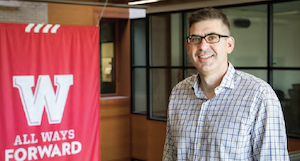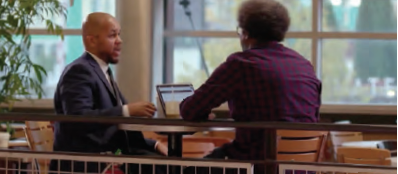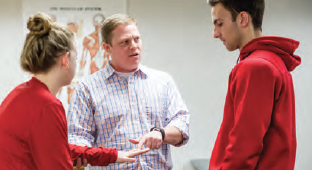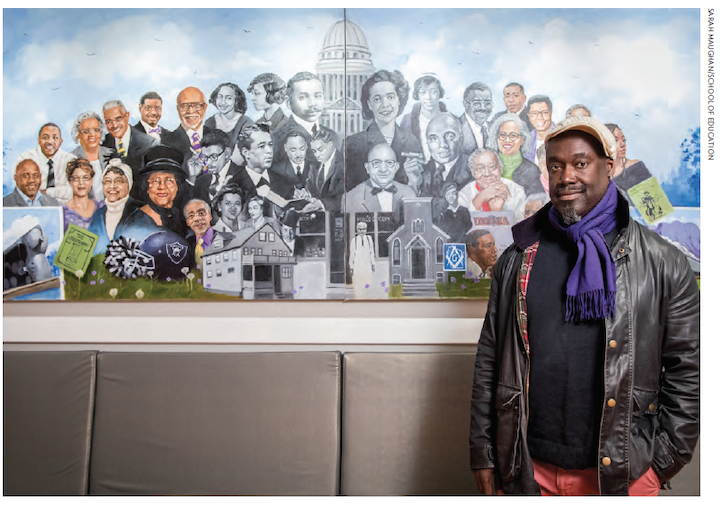Faculty and staff from across UW–Madison’s School of Education are routinely quoted or make their voices heard in newspapers, magazines, and online news media outlets. Similarly, these experts are often interviewed and showcased on a range of local, national, and international radio and television news reports. Over the past year, there have been more than 100 School of Education-related media mentions. For the latest examples, visit: https://news.education.wisc.edu/in-the-media
Time magazine spotlights work of Stoddard, Hess for report on teaching about 9/11
Time magazine in September turned to the expertise of UW–Madison’s Jeremy Stoddard and Diana Hess for a report headlined, “9/11 Is History Now. Here’s How American Kids Are Learning About It In Class.”
Stoddard is an associate professor with the School of Education’s highly regarded Department of Curriculum and Instruction, while Hess is dean of the School of Education and the Karen A. Falk Distinguished Chair of Education.
 As Time explains: “It’s not surprising that teaching 9/11 as history is a delicate task. In addition to the emotional burden that falls on teachers who remember that day, the subject matter is sensitive and the images and documents that might be used as primary sources are disturbing. The story is also very much still being written, as the effects of 9/11 on American society continue to evolve.”
As Time explains: “It’s not surprising that teaching 9/11 as history is a delicate task. In addition to the emotional burden that falls on teachers who remember that day, the subject matter is sensitive and the images and documents that might be used as primary sources are disturbing. The story is also very much still being written, as the effects of 9/11 on American society continue to evolve.”
Time explains how Stoddard has been analyzing how teachers talk about 9/11 in classrooms nationwide, with his new study “polling 1,047 U.S. middle- and high-school teachers. It revealed that the most popular method of teaching about 9/11 and the War on Terror was showing a documentary or ‘similar video.’ ”
The next most cited method was discussing related current events, followed by teachers sharing personal stories. Stoddard explained to Time that younger teachers, in particular, tend to aim to get kids “to feel like they felt that day, to understand the shock and horror people felt that day.”
Time explains how this survey built on Stoddard’s prior research looking at textbooks and classroom resources developed to teach about the event in the first few years after 2001. The report adds how Stoddard and Hess “studied nine of the bestselling high school U.S History, World History, Government, and Law textbooks published in 2004 and 2006, and then did side-by-side comparisons between three of them and editions published in 2009 and 2010, noting how descriptions of the attacks evolved.”
“A lot of the main themes that we saw way back in 2003 — in terms of, it’s a day of remembrance, a focus on the first responders and the heroes of the day and the actions they took, the world coming together in response to this horrible terrorist attack — a lot of those themes are still very much the way it’s being taught,” Stoddard tells Time.
Diamond appears on CNN’s ‘United Shades of America’ to talk about implicit bias
John Diamond in June appeared on CNN’s “United Shades of America” program to talk about implicit bias.
 Diamond, who is an expert on this topic, is the Kellner Family Distinguished Chair in Urban Education and a professor with the School of Education’s Department of Educational Leadership and Policy Analysis.
Diamond, who is an expert on this topic, is the Kellner Family Distinguished Chair in Urban Education and a professor with the School of Education’s Department of Educational Leadership and Policy Analysis.
The episode Diamond appeared on was an installment in a series of get-togethers referred to as “Black People Meetings” by writer and comedian W. Kamau Bell, who hosts “United Shades of America.” In this particular segment, Bell talks about Milwaukee, one of America’s most segregated cities.
Implicit bias is a term that describes the way our brains are affected by growing up within systems that enact oppression, a CNN press release explained in a preview of the show.
During his appearance, Diamond references Project Implicit, an international research collaboration founded in 1998 by scientists at Harvard, the University of Virginia, and the University of Washington, telling CNN that one doesn’t necessarily dislike someone of another race to experience implicit bias.
Diamond describes this kind of bias as “what’s going through people’s minds before they have the time to think about what the socially responsible answer” is. Diamond notes that if someone walks in the door and it’s a man, there are some implicit assumptions that go along with that.
ESPN, USA Today highlight Bell’s research on dangers of youth sports specialization
David Bell is becoming widely recognized as a national leader in examining the risks associated with sports specialization and young athletes.
 Bell is an associate professor with the Department of Kinesiology’s athletic training program, and director of the Wisconsin Injury in Sport Laboratory.
Bell is an associate professor with the Department of Kinesiology’s athletic training program, and director of the Wisconsin Injury in Sport Laboratory.
An ESPN.com report in July from Baxter Holmes put the spotlight on Bell’s work. The report explains how Bell and his colleagues found that while most youth athletes believe specializing in a single sport increases their performance and chances of making a college team, research indicates that a majority of athletes who reached the highest, NCAA Division I level, didn’t classify as highly specialized when they were younger athletes in high school.
While the upsides of specialization are unclear, there are few doubts about the downsides. A separate study from Bell, ESPN reported, found that 36 percent of high school athletes classified as highly specialized, training in one sport for more than eight months a year. The problem? Bell’s work shows that those athletes were two to three times more likely to suffer a hip or knee injury.
The ESPN.com article is headlined: “ ‘These kids are ticking time bombs’: The threat of youth basketball.”
In October, USA Today also noted Bell’s work, writing: “A series of studies in the Journal of Athletic Training about the effects of being a specialized athlete at a young age left researchers with a distinct takeaway: Focusing on one sport at too early an age increases the risk of major, career-threatening injury later in life.”
Washington Post speaks with Borman about helping kids transition to middle school
In late August and in a lead-up to the start of a new academic year, The Washington Post featured comments from Geoffrey Borman in a report, “Five ways parents can help their kids transition smoothly to middle school.”
Borman is a Vilas Distinguished Achievement Professor of Educational Leadership and Policy Analysis.
 The Washington Post article explores the transition from elementary to middle school, a shift that “can seem seismic” to many.
The Washington Post article explores the transition from elementary to middle school, a shift that “can seem seismic” to many.
The article promotes five ways for parents to support their children in transition. One tip the Washington Post suggests is normalizing the feeling of being out of place. Borman notes that
new obstacles in middle school may cause students to question whether they fit in socially or can succeed academically.
The Post explains how Borman, alongside Chris Rozek, a research associate at Stanford University, conducted research to see whether it was possible to bolster students’ sense of belonging by sharing that all students experience difficulty at the start of middle school, but eventually feel better.
As part of this research the Post notes how students read and reflected on comments purportedly made by seventh-graders, who said things such as, “I felt like I had a knot in my stomach in my first few months and was afraid to talk to my teachers. I worried that they thought I was dumb, but they believe in you even when you get bad grades and want to help you get better.”
The results of this study from Borman, published in the journal PNAS, show that students who got the intervention liked school and trusted their teachers more and were more invested in doing well.
U.S. News features expertise of Hillman
in report on higher education deserts
Nick Hillman, a leading researcher in the field of higher education deserts, shared his perspectives on this topic with U.S. News and World Report in May.
Hillman is an associate professor with the School of Education’s Department of Educational Leadership and Policy Analysis, and is the director of UW–Madison’s Student Success through Applied Research Lab.
At a time when two out of every three undergraduates enroll in a two-year or four-year degree program within 25 miles of their home, according to Department of Education data, Hillman urges policymakers to pay attention to one of the most overlooked aspects of college access and opportunity: geographic inequality.
Much of Hillman’s research centers on the topic of educational equity and looking at ways to give more people a fair shot at both accessing, and succeeding in, college. Hillman inspects these issues through a financial lens.
While building new colleges isn’t realistic and online virtual schools present their own set of obstacles, Hillman suggests a boost in Pell Grant funding for students who live in higher education deserts. This idea was being considered by members of Congress as they began working to reauthorize the Higher Education Act.
In other reports …
• The New York Times Magazine in September profiled award-winning author Jacqueline Woodson and her efforts to transform children’s literature and diversify publishing. The report then utilizes the research of the Cooperative Children’s Book Center, housed within the School of Education, to spotlight the dearth of books from black authors and illustrators.
The magazine explains that, according to CCBC research, in 1985, of the estimated 2,500 children’s books published in the United States, only 18 were by black authors or illustrators. The report adds: “Last year, of the 3,653 books submitted to the CCBC, 202 were by African or African-American writers and illustrators — a notable but imperfect improvement.”
• A Wisconsin Public Radio (WPR) report in October examining the relationship between education and health featured the expertise of UW–Madison’s Craig Albers, an associate professor with the Department of Educational Psychology.
The report was titled, “Wisconsin Communities Look to Education to Improve Health.” Albers has traveled to different parts of Wisconsin to ask school officials and parents what obstacles they face in education. He shares that “the most frequently mentioned issue is mental and behavioral health.”
• Julie Stamm, a clinical assistant professor with the Department of Kinesiology, spoke with Parents magazine in September about making the decision on whether to let your kid play football. Concern about concussions has grown in recent years, as has concerns over chronic traumatic encephalopathy (CTE), the progressive brain disease.
Stamm, who has conducted research on both, notes it’s also important to keep tabs on routine hits that happen on every play. Says Stamm: “Some people say, ‘Oh, they’re just playing as a kid’ but if you start at 8 and play until you are 18, that’s 10 years of repeated head impact.”
• Publishers Weekly in September spoke with UW–Madison’s Lynda Barry about her newest work, “Making Comics,” which was released in November. Barry, an associate professor of interdisciplinary creativity with the Art Department, holds the Chazen Family Distinguished Chair in Art. “Making Comics” offers readers methods for learning to tell stories in pictures while unlocking creative connections.
• The Wisconsin State Journal spoke with Peggy Choy leading up to her November performances of “FLIGHT: Torn like a rose.” Choy, a faculty member with the School of Education’s Dance Department, has built the performance’s dance work around her interpretation of the 12th century epic poem, “The Conference of the Birds,” by the Persian poet Farid ud-Din Attar. The poem is designed to inspire people to question their self-interest and worldly gain.
• Madison365.com this fall reported on a new mural at Madison College’s South Campus by Jerry Jordan that represents African-American history in Madison. Jordan, a recruitment and retention specialist with the School of Education’s Student Diversity Programs Office, painted a 10-foot by five-foot mural that depicts 37 people, all black, each with their own story, each pivotal to the history of Black Madison, Madison365.com explains.
